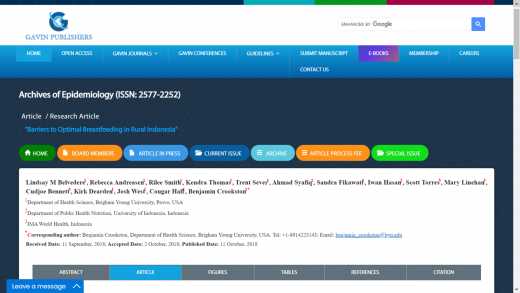Barriers to optimal breastfeeding in rural Indonesia
Peer Reviewed Articles
Barriers to optimal breastfeeding in rural Indonesia
Background: Despite its importance, the rate of exclusive breastfeeding for the first 6 months of life in Indonesia was only 42% as recently as 2012.
Objective: This study examines determinants of breastfeeding behaviors in rural Indonesia.
Methods: We conducted a cross-sectional survey among 2086 women 14-55 years of age, living in seven regions of Indonesia.
Results: Participating mothers had an average age of 28 years old and had 1.9 children on average. Girls (64% vs. 58.2%) were more likely to be breastfed in the first hour of birth than boys (OR=1.268; 95% CI 1.062-1.515). Boys breastfed for an average of 6.4 months, compared to 9.2 months for girls. Nearly half (48.9%, 500/1023) of boys received foods other than breastmilk within the first three days of life, compared to 40.0% (425/1063) of girls. The belief that boys need better nutrition than girls (OR=0.706; 95% CI 0.572-0.872) was associated with lack of exclusive breastfeeding in the first 3 days of life.
Conclusions: Our findings indicate differential exclusive breastfeeding behaviors for male and female children. Health communication strategies promoting optimal breastfeeding behaviors, attitudes and beliefs related to gender and breastfeeding are needed. Addressing cultural practices that contribute to non-exclusive breastfeeding for the first 6 months of life is essential for stainable behavior change.
Read the article

